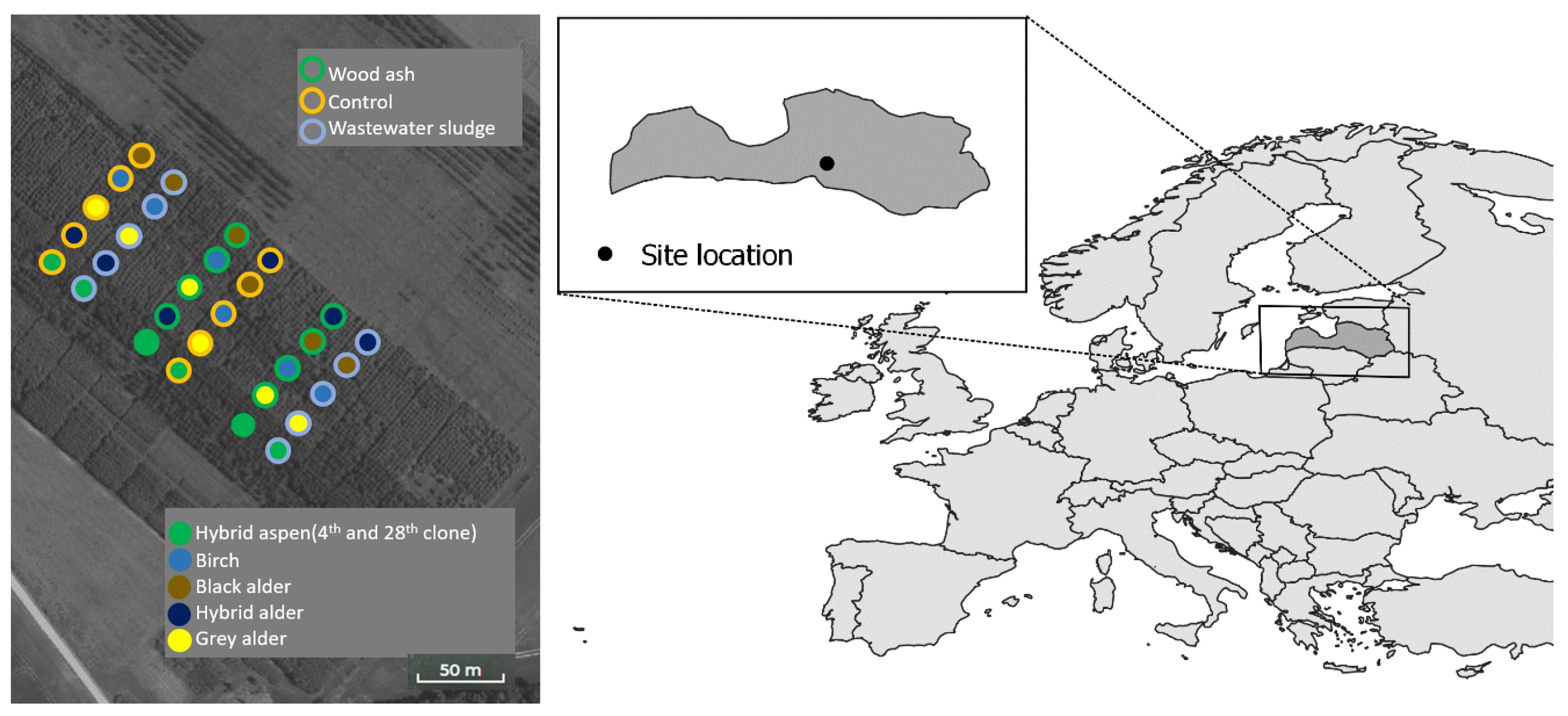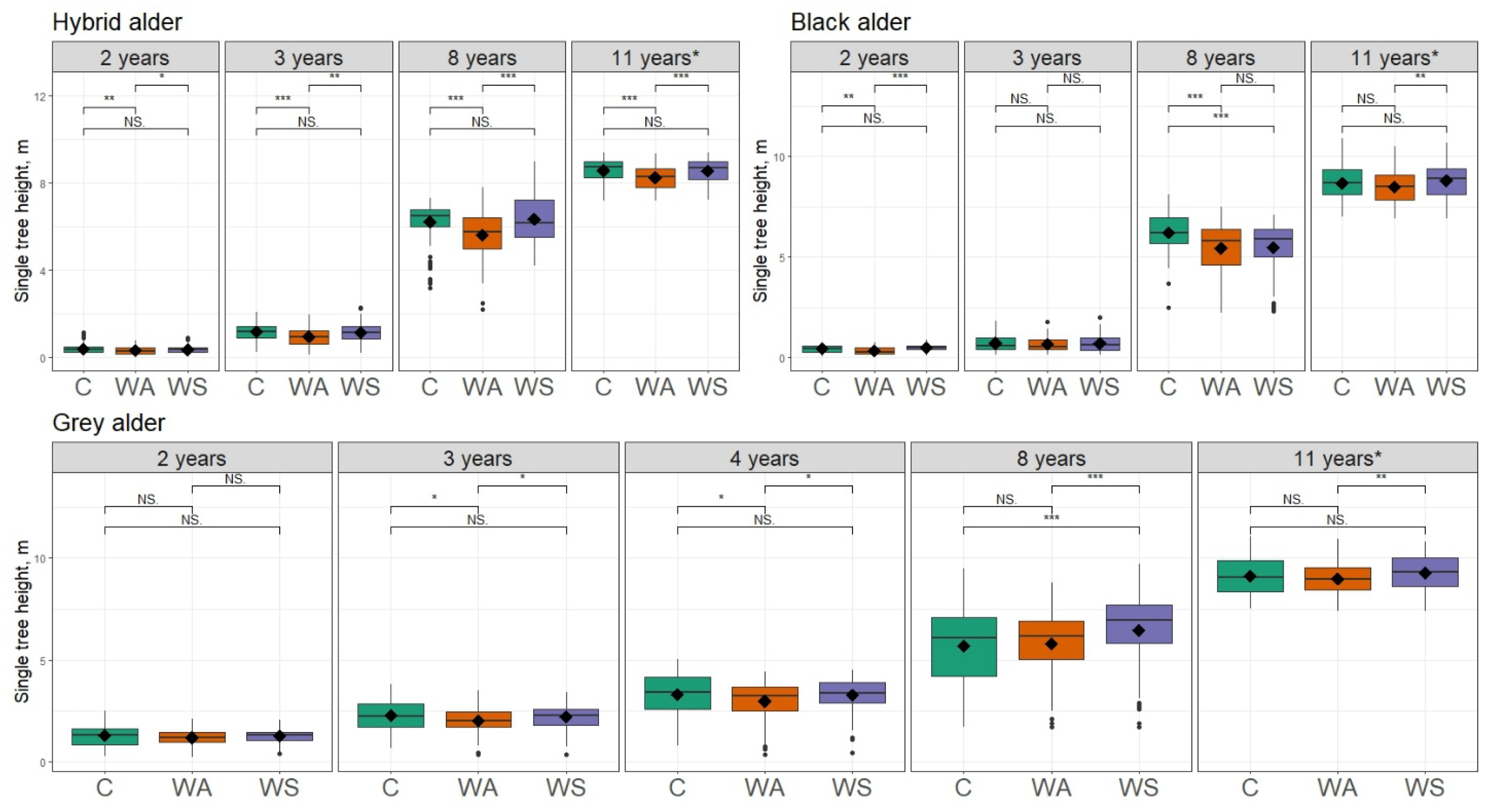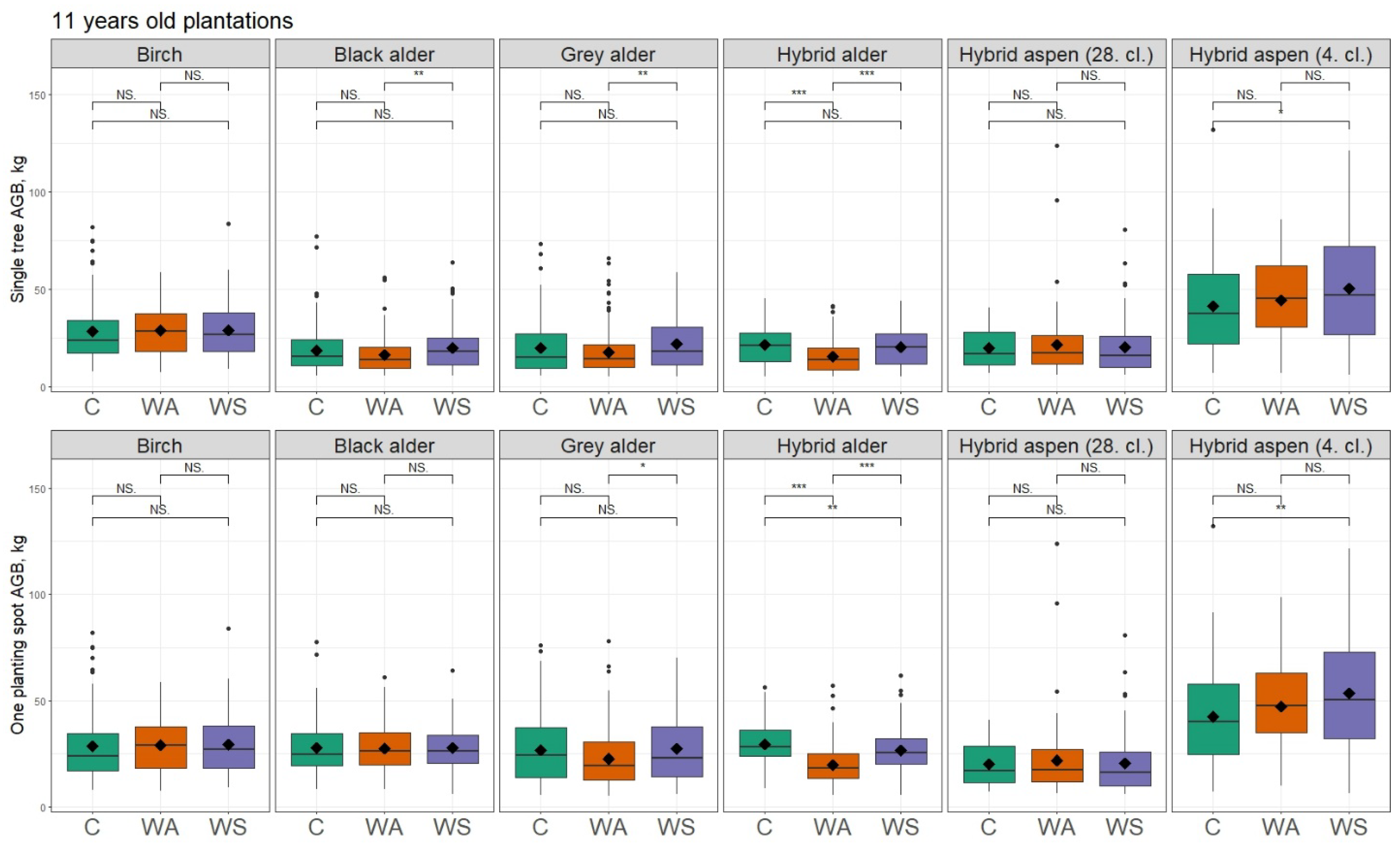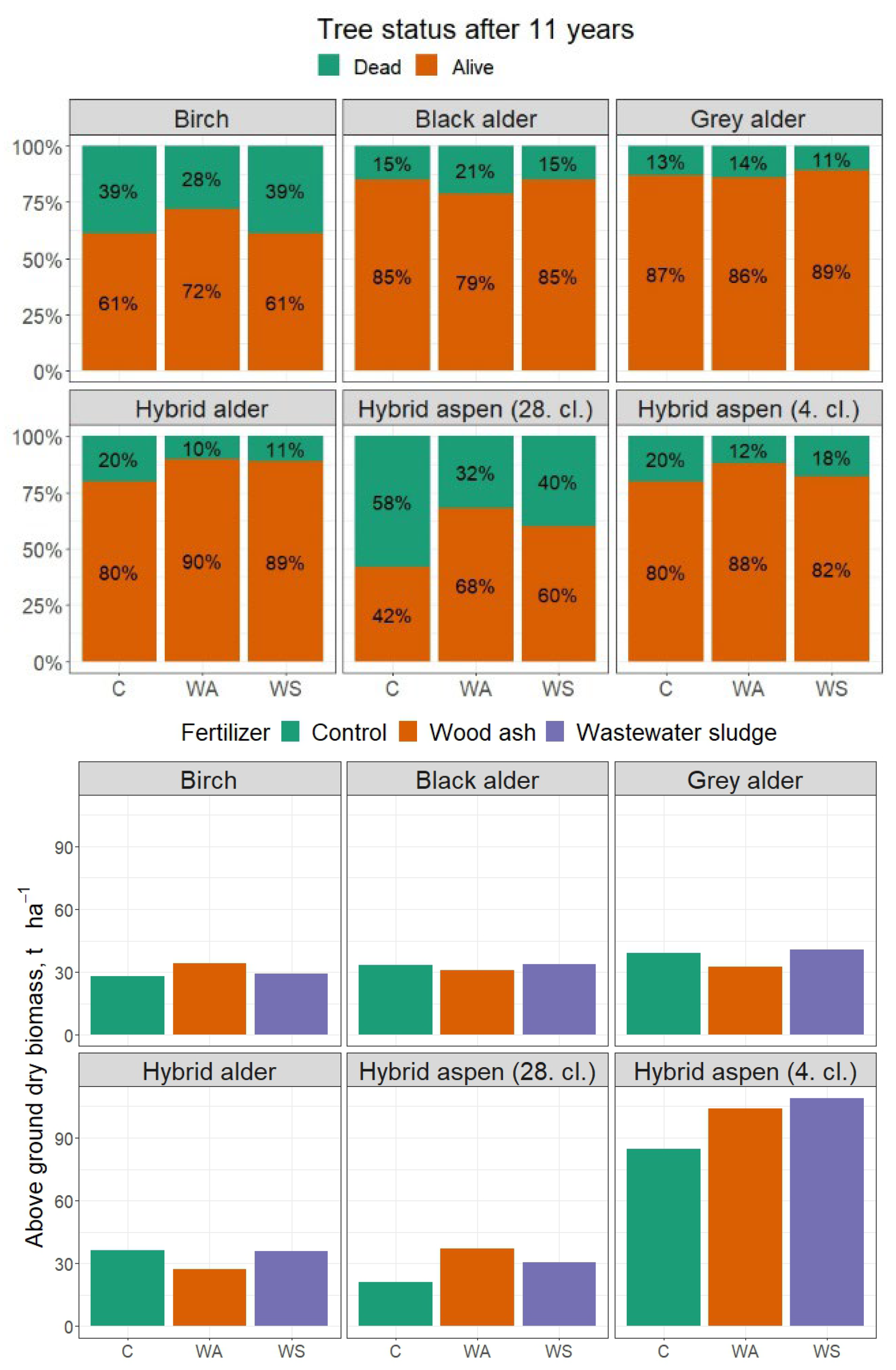Long-Term Effect of Wood Ash and Wastewater Sludge Fertilization on Tree Growth in Short-Rotation Forest Plantations on Abandoned Agricultural Land: A Case Study
Abstract
1. Introduction
2. Materials and Methods
2.1. Study Site
2.2. Study Site Fertilization
2.3. Planting Material
2.4. Height, Diameter, and Aboveground Biomass Calculations
2.5. Statistical Analyses
3. Results
3.1. Fertilization Impact on Single Tree Height
3.2. Single Tree DBH
3.3. Single Tree and Planting Spot Biomass
3.4. Tree Survival Rate and Biomass from One Hectare
4. Discussion
5. Conclusions
Author Contributions
Funding
Institutional Review Board Statement
Informed Consent Statement
Data Availability Statement
Acknowledgments
Conflicts of Interest
References
- Fayet, C.M.J.; Reilly, K.H.; Van Ham, C.; Verburg, P.H. The Potential of European Abandoned Agricultural Lands to Contribute to the Green Deal Objectives: Policy Perspectives. Environ. Sci. Policy 2022, 133, 44–53. [Google Scholar] [CrossRef]
- Satyanarayana, K.G.; Arizaga, G.G.C.; Wypych, F. Biodegradable Composites Based on Lignocellulosic Fibers-An Overview. Prog. Polym. Sci. 2009, 34, 982–1021. [Google Scholar] [CrossRef]
- Ibrahim, H.; Mehanny, S.; Darwish, L.; Farag, M. A Comparative Study on the Mechanical and Biodegradation Characteristics of Starch-Based Composites Reinforced with Different Lignocellulosic Fibers. J. Polym. Environ. 2018, 26, 2434–2447. [Google Scholar] [CrossRef]
- Refate, A.; Mohamed, Y.; Mohamed, M.; Sobhy, M.; Samhy, K.; Khaled, O.; Eidaroos, K.; Batikh, H.; El-Kashif, E.; El-Khatib, S.; et al. Influence of Electrospinning Parameters on Biopolymers Nanofibers, with Emphasis on Cellulose & Chitosan. Heliyon 2023, 9, e17051. [Google Scholar] [CrossRef] [PubMed]
- Christersson, L.; Sennerby-Forsse, L. The Swedish programme for intensive short-rotation forests. Biomass Bioenergy 1994, 6, 145–149. [Google Scholar] [CrossRef]
- Liepiņš, K.; Daugaviete, M.; Zālītis, P. Bērza Plantācijas Lauksaimniecības Zemēs (Birch Plantations on Agriculture Lands); Latvijas Valsta Mežzinātnes Institūts “Silava”: Salaspils, Latvia, 2013; ISBN 9789934821035. [Google Scholar]
- Fahlvik, N.; Rytter, L.; Stener, L.G. Production of Hybrid Aspen on Agricultural Land during One Rotation in Southern Sweden. J. For. Res. 2021, 32, 181–189. [Google Scholar] [CrossRef]
- Rytter, R.M.; Rytter, L. Carbon Sequestration at Land Use Conversion—Early Changes in Total Carbon Stocks for Six Tree Species Grown on Former Agricultural Land. For. Ecol. Manag. 2020, 466, 118129. [Google Scholar] [CrossRef]
- Berthrong, S.T.; Jobba’gy, E.G.; Jobba´gy, J.; Jackson, R.B. A Global Meta-Analysis of Soil Exchangeable Cations, PH, Carbon, and Nitrogen with Afforestation. Ecol. Appl. 2009, 19, 2228–2241. [Google Scholar] [CrossRef]
- Smethurst, P.J. Forest Fertilization: Trends in Knowledge and Practice Compared to Agriculture. Plant Soil 2010, 335, 83–100. [Google Scholar] [CrossRef]
- Marron, N. Agronomic and Environmental Effects of Land Application of Residues in Short-Rotation Tree Plantations: A Literature Review. Biomass Bioenergy 2015, 81, 378–400. [Google Scholar] [CrossRef]
- Rytter, L.; Rytter, R.M. Growth and Carbon Capture of Grey Alder (Alnus incana (L.) Moench.) under North European Conditions—Estimates Based on Reported Research. For. Ecol. Manag. 2016, 373, 56–65. [Google Scholar] [CrossRef]
- Ingerslev, M.; Skov, S.; Sevel, L.; Pedersen, L.B. Element Budgets of Forest Biomass Combustion and Ash Fertilisation—A Danish Case-Study. Biomass Bioenergy 2011, 35, 2697–2704. [Google Scholar] [CrossRef]
- Demeyer, A.; Voundi Nkana, J.C.; Verloo, M.G. Characteristics of Wood Ash and Influence on Soil Properties and Nutrient Uptake: An Overview. Bioresour. Technol. 2001, 77, 287–295. [Google Scholar] [CrossRef] [PubMed]
- Väätäinen, K.; Sirparanta, E.; Räisänen, M.; Tahvanainen, T. The Costs and Profitability of Using Granulated Wood Ash as a Forest Fertilizer in Drained Peatland Forests. Biomass Bioenergy 2011, 35, 3335–3341. [Google Scholar] [CrossRef]
- Hao, X.; Chen, Q.; van Loosdrecht, M.C.M.; Li, J.; Jiang, H. Sustainable Disposal of Excess Sludge: Incineration without Anaerobic Digestion. Water Res. 2020, 170, 115298. [Google Scholar] [CrossRef] [PubMed]
- Jain, M.S.; Paul, S.; Kalamdhad, A.S. Utilization of Biochar as an Amendment during Lignocellulose Waste Composting: Impact on Composting Physics and Realization (Probability) amongst Physical Properties. Process Saf. Environ. Prot. 2019, 121, 229–238. [Google Scholar] [CrossRef]
- Rutgersson, C.; Ebmeyer, S.; Lassen, S.B.; Karkman, A.; Fick, J.; Kristiansson, E.; Brandt, K.K.; Flach, C.F.; Larsson, D.G.J. Long-Term Application of Swedish Sewage Sludge on Farmland Does Not Cause Clear Changes in the Soil Bacterial Resistome. Environ. Int. 2020, 137, 105339. [Google Scholar] [CrossRef]
- Elmi, A.; Al-Khaldy, A.; AlOlayan, M. Sewage Sludge Land Application: Balancing Act between Agronomic Benefits and Environmental Concerns. J. Clean. Prod. 2020, 250, 119512. [Google Scholar] [CrossRef]
- Fytili, D.; Zabaniotou, A. Utilization of Sewage Sludge in EU Application of Old and New Methods-A Review. Renew. Sustain. Energy Rev. 2008, 12, 116–140. [Google Scholar] [CrossRef]
- Moral, R.; Cort, A.; Gomez, I.; Mataix-Beneyto, J. Assessing Changes in Cd Phytoavailability to Tomato in Amended Calcareous Soils. Bioresour. Technol. 2002, 85, 63–68. [Google Scholar] [CrossRef]
- Lazdiņa, D.; Liepiņš, K.; Bārdule, A.; Liepiņš, J.; Bārdulis, A. Wood Ash and Wastewater Sludge Recycling Success in Fast-Growing Deciduous Tree-Birch and Alder Plantations. Agron. Res. 2013, 11, 347–356. [Google Scholar]
- Newton, P.F.; Amponsah, I.G. Systematic Review of Short-Term Growth Responses of Semi-Mature Black Spruce and Jack Pine Stands to Nitrogen-Based Fertilization Treatments. For. Ecol. Manag. 2006, 237, 1–14. [Google Scholar] [CrossRef]
- Karklins, A.; Rancane, S. Augsnes Apraksts; Volume Registar Number AI0103; Skrīveri: Salaspils, Latvia, 2012. [Google Scholar]
- Food and Agriculture Organization of the United Nations. World Reference Base for Soil Resources 2014: International Soil Classification System for Naming Soils and Creating Legends for Soil Maps; FAO: Rome, Italy, 2014; ISBN 9789251083697. [Google Scholar]
- LVGMC: Latvian Environment, Geology and Meteorology Centre. Meteorological Network. Available online: https://Videscentrs.Lvgmc.Lv/ (accessed on 20 August 2023).
- Naslund, M. Forest Research Institute’s Thinning Experiments in Scots Pine Forests. Medd. Från Statens Skogsförsöksanstalt 1937, 29, 169. [Google Scholar]
- Liepiņš, J.; Liepiņš, K.; Lazdiņš, A. Equations for Estimating the Above- and Belowground Biomass of Grey Alder (Alnus incana (L.) Moench.) and Common Alder (Alnus glutinosa L.) in Latvia. Scand J. For. Res. 2021, 36, 389–400. [Google Scholar] [CrossRef]
- Liepiņš, J.; Lazdiņš, A.; Liepiņš, K. Equations for Estimating Above- and Belowground Biomass of Norway Spruce, Scots Pine, Birch Spp. and European Aspen in Latvia. Scand J. For. Res. 2018, 33, 58–70. [Google Scholar] [CrossRef]
- R Core Team. R: A Language and Environment for Statistical Computing; R Foundation for Statistical Computing: Vienna, Austria, 2022. [Google Scholar]
- Pukkala, T. Optimal Nitrogen Fertilization of Boreal Conifer Forest. For. Ecosyst. 2017, 4, 3. [Google Scholar] [CrossRef]
- Lazdina, D.; Lazdinš, A.; Karinš, Z.; Kāposts, V. Effect of Sewage Sludge Fertilization in Short-Rotation Willow Plantations. J. Environ. Eng. Landsc. Manag. 2007, 15, 105–111. [Google Scholar] [CrossRef]
- Hytönen, J.; Aro, L. Biomass and Nutrition of Naturally Regenerated and Coppiced Birch on Cutaway Peatland During 37 Years. Silva Fenn. 2012, 46, 337–394. [Google Scholar] [CrossRef][Green Version]
- Kikamägi, K.; Ots, K.; Kuznetsova, T. Effect of Wood Ash on the Biomass Production and Nutrient Status of Young Silver Birch (Betula Pendula Roth) Trees on Cutaway Peatlands in Estonia. Ecol. Eng. 2013, 58, 17–25. [Google Scholar] [CrossRef]
- Hytotnen, J.; Saarsalmi, A.; Rossi, P. Biomass Production and Nutrient Uptake of Short Rotation Plantations. Silva Fenn. 1995, 29, 117–139. [Google Scholar]
- Saarsalmi, A.; Mälkönen, E. Forest Fertilization Research in Finland: A Literature Review. Scand J. For. Res. 2001, 16, 514–535. [Google Scholar] [CrossRef]
- Okmanis, M.; Skranda, I.; Lazdiņš, A.; Lazdiņa, D. Impact of wood ash and potassium sulphate fertilization on growth of norway spruce stand on organic soil. In Proceedings of the Annual 22nd International Scientific Conference: “Research for Rural Development 2016” Volume 2, Jelgava, Latvia, 18–20 May 2016. [Google Scholar]
- Jansone, B.; Samariks, V.; Okmanis, M.; Kļaviņa, D.; Lazdiņa, D. Effect of High Concentrations of Wood Ash on Soil Properties and Development of Young Norway Spruce (Picea abies (L.) Karst) and Scots Pine (Pinus sylvestris L.). Sustainability 2020, 12, 9479. [Google Scholar] [CrossRef]
- Jansons, Ā.; Matisons, R.; Krišāns, O.; Džeriņa, B.; Zeps, M. Effect of Initial Fertilization on 34-Year Increment and Wood Properties of Norway Spruce in Latvia. Silva Fenn. 2016, 50, 1346. [Google Scholar] [CrossRef]
- Hanssen, K.H.; Asplund, J.; Clarke, N.; Selmer, R.; Nybakken, L. Fertilization of Norway Spruce Forest with Wood Ash and Nitrogen Affected Both Tree Growth and Composition of Chemical Defence. Forestry 2021, 93, 589–600. [Google Scholar] [CrossRef]
- Hytönen, J.; Saarsalmi, A. Biomass Production of Coppiced Grey Alder and the Effect of Fertilization. Silva Fenn. 2015, 49, 1260. [Google Scholar] [CrossRef]
- Rytter, L.; Slapokas, T.; Granhall, U. Woody Biomass and Litter Production of Fertilized Grey Alder Plantations on a Low-Humified Peat Bog. For. Ecol. Manag. 1989, 28, 161–176. [Google Scholar] [CrossRef]
- Georgiadis, P.; Taeroe, A.; Stupak, I.; Kepfer-Rojas, S.; Zhang, W.; Pinheiro Bastos, R.; Raulund-Rasmussen, K. Fertilization Effects on Biomass Production, Nutrient Leaching and Budgets in Four Stand Development Stages of Short Rotation Forest Poplar. For. Ecol. Manag. 2017, 397, 18–26. [Google Scholar] [CrossRef]
- Ingerslev, M.; Hansen, M.; Pedersen, L.B.; Skov, S. Effects of Wood Chip Ash Fertilization on Soil Chemistry in a Norway Spruce Plantation on a Nutrient-Poor Soil. For. Ecol. Manag. 2014, 334, 10–17. [Google Scholar] [CrossRef]
- Rytter, L.; Stener, L.G. Productivity and Thinning Effects in Hybrid Aspen (Populus tremula L. × P. tremuloides Michx.) Stands in Southern Sweden. Forestry 2005, 78, 285–295. [Google Scholar] [CrossRef]
- Tullus, A.; Tullus, H.; Soo, T.; Pärn, L. Above-Ground Biomass Characteristics of Young Hybrid Aspen (Populus tremula L. × P. tremuloides Michx.) Plantations on Former Agricultural Land in Estonia. Biomass Bioenergy 2009, 33, 1617–1625. [Google Scholar] [CrossRef]
- Zeps, M. Potential of Hybrid Aspen (Populus tremuloides Michx. × Populus tremula L.) Production in Latvia. Ph.D. Thesis, Latvia University of Agriculture, Jelgava, Latvia, 2017. [Google Scholar]
- Aosaar, J.; Uri, V. Biomass Production of Grey Alder, Hybrid Alder and Silver Birch Stands on Abandoned Agricultural Land. For. Stud. 2008, 48, 53–66. [Google Scholar] [CrossRef]
- Aosaar, J.; Varik, M.; Uri, V. Biomass Production Potential of Grey Alder (Alnus incana (L.) Moench.) in Scandinavia and Eastern Europe: A Review. Biomass Bioenergy 2012, 45, 11–26. [Google Scholar] [CrossRef]
- Uri, V.; Lõhmus, K.; Kiviste, A.; Aosaar, J. The Dynamics of Biomass Production in Relation to Foliar and Root Traits in a Grey Alder (Alnus incana (L.) Moench) Plantation on Abandoned Agricultural Land. Forestry 2009, 82, 61–74. [Google Scholar] [CrossRef]
- Johansson, T. Biomass Equations for Determining Fractions of Common and Grey Alders Growing on Abandoned Farmland and Some Practical Implications. Biomass Bioenergy 2000, 18, 147–159. [Google Scholar] [CrossRef]
- Daugaviete, M.; Lazdins, A.; Lazdina, D.; Makovskis, K.; Daugavietis, U. Growth and Yield of 15-Year Plantations of Pine, Spruce and Birch in Agricultural Land. Rural. Sustain. Res. 2017, 37, 38–50. [Google Scholar] [CrossRef][Green Version]
- Lutter, R.; Tullus, A.; Kanal, A.; Tullus, T.; Vares, A.; Tullus, H. Growth Development and Plant–Soil Relations in Midterm Silver Birch (Betula Pendula Roth) Plantations on Previous Agricultural Lands in Hemiboreal Estonia. Eur. J. For. Res. 2015, 134, 653–667. [Google Scholar] [CrossRef]
- Bjorklund, T.; Ferm, A. Pienikokoisen Koivun Ja Harmaalepan Biomassa Ja Tekniset Ominaisuudet. Summary: Biomass and Technical Properties of Small-Sized Birch and Grey Alder. Folia For. 1982, 500, 1–37. [Google Scholar]
- Ferm, A.; Kaunisto, S. Luontaisesti Syntyneiden Koivumetsikoiden Maanpaallinen Lehdeton Biomassatuotos Entisella Turpeennostoalueella Kihnion Aitonnesevalla. Summary: Above-Ground Leafess Biomass Production of Naturally Generated Birch Stands in a Peat Cut-over Area at Aitonneseva, Kihnio. Folia For. 1983, 558, 1–32. [Google Scholar]
- Johansson, T. Biomass Equations for Determining Fractions of Pendula and Pubescent Birches Growing on Abandoned Farmland and Some Practical Implications. Biomass Bioenergy 1999, 16, 223–238. [Google Scholar] [CrossRef]
- Johansson, T. Biomass Production and Allometric Above- and below-Ground Relations for Young Birch Stands Planted at Four Spacings on Abandoned Farmland. Forestry 2007, 80, 41–52. [Google Scholar] [CrossRef]







| Fertilizer | Fertilization Dose | Origin | Major Nutrient Inputs through Fertilization | ||
|---|---|---|---|---|---|
| Ntot | Ptot | Ktot | |||
| Wood ash | 6 t DM ha−1 | Boiler house, Sigulda | 2.6 | 65 | 190 |
| Wastewater sludge | 10 t DM ha−1 | Wastewater treatment plant, Aizkraukle | 259 | 163 | 22 |
| Tree Species | Planting Material Supplier | Planting Scheme (m) | Planting Density (Trees ha−1) | Trees Planted in One Subplot (2011) |
|---|---|---|---|---|
| Hybrid aspen clone No. 28 (Populus tremuloides Michx. × Populus tremula L.) | JSC “Latvian State Forests” nursery in Kalsnava | 2.0 × 2.0 m | 2500 | 55 |
| Hybrid aspen clone No. 4 (Populus tremuloides Michx. × Populus tremula L.) | JSC “Latvian State Forests” nursery in Kalsnava | 2.0 × 2.0 m | 2500 | 55 |
| Silver birch (Betula pendula Roth) | JSC “Latvijas Finieris” nursery “Zabaki” | 2.5 × 2.5 m | 1600 | 72 |
| Grey alder (Alnus incana (L.)) | JSC “Latvijas Finieris” nursery “Zabaki” | 2.5 × 2.5 m | 1600 | 72 |
| Black alder (Alnus glutinosa (L.)) | JSC “Latvijas Finieris” nursery “Zabaki” | 2.5 × 2.5 m | 1600 | 72 |
| Hybrid alder (Alnus hybrida A. Br) | LSFRI “Silava” and forest research station nursery in Kalsnava | 2.5 × 2.5 m | 1600 | 72 |
Disclaimer/Publisher’s Note: The statements, opinions and data contained in all publications are solely those of the individual author(s) and contributor(s) and not of MDPI and/or the editor(s). MDPI and/or the editor(s) disclaim responsibility for any injury to people or property resulting from any ideas, methods, instructions or products referred to in the content. |
© 2023 by the authors. Licensee MDPI, Basel, Switzerland. This article is an open access article distributed under the terms and conditions of the Creative Commons Attribution (CC BY) license (https://creativecommons.org/licenses/by/4.0/).
Share and Cite
Makovskis, K.; Dūmiņš, K.; Štāls, T.A.; Vendiņa, V.; Bārdule, A.; Lazdiņa, D. Long-Term Effect of Wood Ash and Wastewater Sludge Fertilization on Tree Growth in Short-Rotation Forest Plantations on Abandoned Agricultural Land: A Case Study. Sustainability 2023, 15, 16272. https://doi.org/10.3390/su152316272
Makovskis K, Dūmiņš K, Štāls TA, Vendiņa V, Bārdule A, Lazdiņa D. Long-Term Effect of Wood Ash and Wastewater Sludge Fertilization on Tree Growth in Short-Rotation Forest Plantations on Abandoned Agricultural Land: A Case Study. Sustainability. 2023; 15(23):16272. https://doi.org/10.3390/su152316272
Chicago/Turabian StyleMakovskis, Kristaps, Kārlis Dūmiņš, Toms Artūrs Štāls, Viktorija Vendiņa, Arta Bārdule, and Dagnija Lazdiņa. 2023. "Long-Term Effect of Wood Ash and Wastewater Sludge Fertilization on Tree Growth in Short-Rotation Forest Plantations on Abandoned Agricultural Land: A Case Study" Sustainability 15, no. 23: 16272. https://doi.org/10.3390/su152316272
APA StyleMakovskis, K., Dūmiņš, K., Štāls, T. A., Vendiņa, V., Bārdule, A., & Lazdiņa, D. (2023). Long-Term Effect of Wood Ash and Wastewater Sludge Fertilization on Tree Growth in Short-Rotation Forest Plantations on Abandoned Agricultural Land: A Case Study. Sustainability, 15(23), 16272. https://doi.org/10.3390/su152316272







